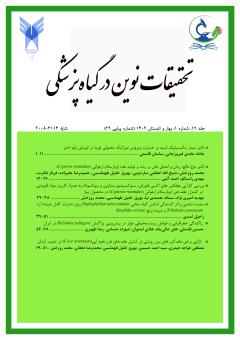تاثیر تیمار سالیسیلیک اسید بر خسارت ویروس موزائیک معمولی لوبیا در لوبیای رقم اختر
محورهای موضوعی : بیماری شناسی گیاهیساسان قاسمی 1 * , عادله عابدی فیروزجایی 2
1 -
2 - دانشگاه آزاد اسلامی، شیراز
کلید واژه: شدت آلودگی, الیزا, لوبیا, ویروس موزائیک لوبیا, سالیسیلیک اسید,
چکیده مقاله :
ویروس موزاییک لوبیا و نژادهای وابسته به آنها از مهمترین بیماری های ویروسی لوبیا هستند و تقریبا در تمام مناطق کشت لوبیا وجود دارند.به منظور بررسی اثرات تیمار سالیسیلیک اسید بر واکنش رقم حساس لوبیا (اختر) به ویروس موزائیک معمولی لوبیا (BCMV)، آزمایشی در قالب طرح کاملا تصادفی با 4 تکرار در شرایط گلخانه اجرا شد. تیمارهای آزمایشی شامل غلظت های صفر، 200، 400 و800 میکرومولار سالیسیلیک اسید در نظر گرفته شد. تیمارهای مورد نظر سه روز قبل از مایه زنی با عامل ویروس مربوطه انجام شد. با انجام آزمون سرولوژیکی ELISA با استفاده از آنتی سرم BCMV آلودگی 3/83 درصد نمونه به این ویروس تائید گردید. نتایج نشان داد سطوح مختلف سالیسیلیک اسید توانستند شدت بیماری را در مقایسه با شاهد آلوده به ویروس کاهش دهند. کمترین شدت بیماری در تیمار کاربرد اسید سالیسیلیک با غلظت 800 میکرومولار (5/15درصد) بدست آمد. میزان فنل برگ در تیمار اسید سالیسیلیک با غلظت 800 میکرومولار (92 درصد) بالاترین مقدار را نشان داد که به لحاظ آماری با شاهد آلوده اختلاف آماری معنی داری نشان نداد که این صفت می تواند نشانگر القاء مقاومت با بهبود سطوح فنل در اثر کاربرد سالیسیلیک اسید باشد. سالیسیلیک اسید توانست در بهبود پارامتر های مرفولوژیک مانند وزن تر بخش های هوایی بوته و وزن خشک ریشه موثر باشد و در شرایط بیماری مانع از آسیب های بیشتر در طول دوره ی آزمایشی شود به حدی که این میزان در تیمار اسید سالیسیلیک با غلظت 800 میکرومولار در شرایط بیماری تفاوت معنی داری با شاهد سالم نشان ندادند.
Bean common mosaic virus and related races are one of the most important bean viral diseases and are present in almost all bean growing regions. In order to investigate the effects of salicylic acid treatment on the reaction of sensitive bean variety (Akhtar) to common bean mosaic virus (BCMV), an experiment was conducted in the form of a completely randomized design with 4 replications in greenhouse conditions. The experimental treatments included concentrations of zero, 200, 400 and 800 micromolar salicylic acid. The desired treatments were performed three days before inoculation with the respective virus agent. ELISA test using BCMV antiserum showed 83.3% of samples were infected with this virus. The results showed that different levels of salicylic acid could reduce the severity of the disease compared to the control infected with the virus.The lowest severity of the disease was obtained in the treatment of salicylic acid with a concentration of 800 micromolar (15.5%). The amount of phenol in the leaves in the treatment of salicylic acid with a concentration of 800 micromolar showed the highest value (92%), which did not show a statistically significant difference with the infected control, and this trait can be an indicator of the induction of resistance with the improvement of phenol levels due to the use of salicylic acid. Salicylic acid was effective in improving the morphological parameters such as the wet weight of the aerial parts of the plant and the dry weight of the root, and in disease conditions it prevented further damage during the experimental period to such an extent that this amount in the treatment of salicylic acid with a concentration of 800 µM in the conditions of the disease did not show any significant difference with the healthy control.
_||_

